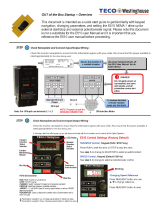
Product information
Introduction
Eaton's Service Information MN225014EN provides the
installation, operation, and maintenance instructions for
its Cooper Power™ series pad-mounted voltage regulator
incorporating its Cooper Power series Quik-Drive™ tap-
changer.
Read this manual first
Read and understand the contents of this manual and
follow all locally approved procedures and safety practices
before installing or operating this equipment. Read and
understand the manual detailing the installation and
operation of the control used with this regulator. Refer to
Service Information MN225003EN CL-7 Voltage Control
Installation, Operation, and Maintenance Instructions for
information on the CL-7 voltage regulator control.
Additional information
These instructions cannot cover all details or variations in
the equipment, procedures, or processes described nor
provide directions for meeting every possible contingency
during installation, operation, or maintenance. For additional
information, please contact your Eaton representative.
Acceptance and initial inspection
The regulator is thoroughly tested and inspected at the
factory. It is carefully calibrated, adjusted, and in good
condition when accepted by the carrier for shipment.
Upon receipt of the regulator shipment, before unloading, a
thorough inspection should be made for damage, evidence
of rough handling, or shortages. The position indicator,
junction box, arrester, radiators, bushings and cabinet
should all be inspected for evidence of damage. Should this
initial inspection reveal evidence of rough handling, damage,
or shortages, it should be noted on the bill of lading and a
claim should immediately be made with the carrier. Also,
notify your Eaton representative.
Handling and storage
Be careful during handing and storage of equipment to
minimize the possibility of damage. If the regulator will not
be placed into immediate service, it can be stored with
minimal precautions. Store the unit where the possibility of
mechanical damage is minimized.
Unloading
Most of the weight of the pad-mount voltage regulator is
in the main tank, which holds the core and coil assembly
and the insulating fluid. The terminal compartments are
largely empty and weigh relatively little. Improper use of
lifts or jacks could seriously damage the regulator or its
attachments or cause serious personal injury.
Moving regulator shipped on pallets
Regulators shipped on pallets may be lifted or moved using
forklift trucks of proper capacity. Pallet-mounted equipment
may also be moved by crane or hoist.
Lifting the regulator by crane or hoist
For unloading, lift lugs are provided near the top of the
regulator tank. Lifting strap angles should not be over 30°
from vertical. Otherwise, a spreader bar should be used to
hold the lifting straps apart or damage to the tank and lift
lugs may result.
Do not attempt to lift the regulator by placing a continuous
loop of strapping, cable, or chain around the unit or lifting
lugs.
Moving the regulator with rollers
The regulator may be skidded or moved with rollers. When
jacking a regulator to insert rollers underneath, ensure that
at least two jacks are used and that two adjacent corners
are raised simultaneously and evenly to avoid warping
the base. Jacks may be placed only at the corners of the
regulator base.
Place jacks only under jack pads provided. When moving the
pad-mounted regulator using rollers, use as many rollers as
necessary to uniformly distribute the weight. To pull, attach
pulling eyes to the holes in the base at either end of the
regulator. Do not attach pulling lines to moldings or other
sheet metal parts of the regulator.
Standards
Eaton's voltage regulators are designed and tested in
accordance with the following standards:
IEEE Std C37.90.1-2012™ standard
IEEE Std C37.90.2-2004™ standard
IEEE Std C57.13-2008™ standard
IEEE Std C57.15-2009™ standard
IEEE Std C37.91-2011™ standard
IEEE Std C57.131-2012™ standard
WARNING
Before moving the regulator, check the weight and tank
capacity and condition of all lifting equipment. Do not
use worn, frayed, or damaged cables or slings. Do not use
lifting machinery with load capacity less than the weight
of the regulator as shown on the nameplate. Improper
moving or lifting may result in severe personal injury,
death, or property damage.
WARNING
Equipment damage. Do not place jacks under radiator,
corrugate, valves or sheet metal parts. Jacking under
these components will cause damage to the equipment.
1
PAD-MOUNTED VOLTAGE REGULATOR WITH QUIK-DRIVE TAP-CHANGER INSTRUCTIONS MN225014EN





















